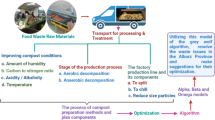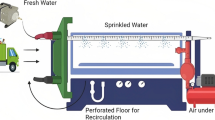Abstract
Aerobic fermentation composting can transform solid organic waste into biological organic fertiliser, while reducing resource wastage and ecological damage. However, in the composting process, a serious loss of nitrogen occurs, primarily in the form of the release of ammonia gas. The release of ammonia gas not only pollutes the environment, but also diminishes the presence of nutrient elements, resulting in compost products that are lower in quality. Given that many factors influence the release of ammonia gas during the aerobic fermentation process, it is difficult to determine optimal process parameters. In an effort to address this issue, we propose herein a combinational weighting method based on the analytic hierarchy process (AHP) and entropy weighting method to determine the weight of each secondary index. We also establish a parametric optimisation model based on the ammonia release conditions of the ELECTRE-I method that provides a theoretical underpinning and a decision basis for optimising the process parameters that mediate the release of ammonia during the aerobic fermentation process. This method can be widely employed to reduce the release of ammonia gas and may be of significance to the future development of bioengineering-based composting technology.




Similar content being viewed by others
References
Zhao YC (2002) Principles and technology of domestic waste resource. Beijing: Chemical Industry Press: 140
Cai WW, Chen LH, Wang WM, Ju J, Feng HC (2014) Summary of town kitchen waste aerobic composting research in China. Soil Fert Sci China 6:8
Maeda K, Hanajima D, Toyoda S, Yoshida N, Morioka R, Osada T (2011) Microbiology of nitrogen cycle in animal manure compost. Microb Biotechnol 4(6):700–709
Huang X, Li H, Jiang H, Quan J, Zhang Y, Gan D (2019) Design and simulation study on waste heat recovery system for an organic aerobic fermentation tank. Environ Eng 37(07):194–198
Huang J (2018) Research and design of aerobic fermentation tank for farming waste .Master thesis, Guangxi University
Huang ZL (2012) Control of ammonia loss in cow manure and straw compost. Master thesis, Kunming University of Technology
Yu J, Zhao S, Sun C, Yang H, Qian J, Gao C, Peng Y (2017) Research and influencing factors of nitrogen fixation in aerobic fermentation of livestock and poultry manure. Environ Sci Manag 42(8):83–88
Zhang Y, Sun C, Duan Z, Chen L, Wu Z, Ma X, Wang J (2010) Research progress on reducing nitrogen loss from compost system. Chin J Soil Sci 41(4):1000–1004
Yao HY (2015) Research on nitrogen conservation technology of organic waste composting. Agric Technol 35(9):19–21
Wang F, Yan H (2011) Orthogonal experiment to optimize ammonia release conditions in fermentation. J Anhui Agric Sci 39(3):1290–1291
Jing XZ, Yan H, Wang F (2011) Artificial neural network (ANN) to optimize ammonia release during fermentation. J Anhui Agric Sci 39(34):21278–21279
Strik D, Domnanovich AM, Zani L, Braun R, Holubar P (2005) Prediction of trace compounds in biogas from anaerobic digestion using the MATLAB Neural Network Toolbox. Environ Modell Softw 20(6):803–810
Liu HM (2017) Process optimization for greenhouse gas emissions and nitrogen loss in sewage sludge composting. Master thesis, Harbin Institute of Technology
Ye CS, Liang CY, Chen R (2011) Multi-attribute decision making methods based on ELECTRE methodology. Journal of Management Science of the Thirteenth Annual Conference of China.
Zhao N, Li Q (2011) Application of ELECTRE I method in the selection of river section design schemes. Mech Manuf 49(04):1–4
Hu XF, Tang GB, Zhao JC, Pan FC, Huang FC (2018) Optimization of grease formulation for large gear ring of ball mill based on ELECTRE-I method. Lubr Eng 43(06):108–113
Li K, Han DC, Li Z (2014) Supplier selection study based on ELECTRE-I method. Chin Mark 6:11–14
Liang Y, Leonard JJ, Feddes JJR, McGill WB (2006) Influence of carbon and buffer amendment on ammonia volatilization in composting. Bioresour Technol 97(5):748–761
Wei J, Xiong J, Yuan L, Zhang Y, Yin Z, Ni W (2017) Influencing factors of ammonia emission and nitrogen transformation in aerobic composting: a review. J Hangzhou Norm Univ Nat Sci Edu 16(1):80–85
Li JJ, Hao JM, Zou GY, Zhang YS, Wang MJ (2004) Advance on composting of livestock manure and its industry production. J Agric Sci Technol 6(3):50–53
Bhradwaj KKR (1995) Improvements in microbial compost technology: a special reference to mcirobiology of composting. Ph.D thesis, New Delhi:Wealth from waste. Tata Energy Research Instiute
Tang XZ, Lan MX, Jing JF, Su MR, Huang FC (2014) Optimization of lubricant formulation based on combination weight-grey relation projection method. Lubr Eng 39(6):108–111
Cao M, Yang L, Guo S, Xiao X, Yu W, Jia R (2019) Research on comprehensive benefit evaluation method of “Coal to Electricity” project based on combination weighting method. Energ Conserv 3:66–70
Zhu YX, Tian DZ, Yan F (2020) Effectiveness of entropy weight method in decision-making. Math Probl Eng 2020
Zhang HB, Chen C, Li MQ, Guo CL (2019) Route choice decision model for driver based on three-scale analytic hierarchy process. Sci Tech Eng 19(20):369–374
Acknowledgements
This study was supported by the following financial support: Scientific Research and Technology Development Program of Guangxi “Development and Application of Kitchen Waste Recycling Technology” (Guike AB16380249); Nanning Science and Technology Planning Project “Research on Food Waste Recycling and Recycling Technology” (Project no.: 20170190); Guigang Science and Technology Planning Project” R&D and Industrialization Demonstration of New Environmental Protection Total Nutritional Algae Fertilizer”(Project no.: 20180966); Chongzuo Key Research and Development Program “Research and application of key technologies for comprehensive utilization of livestock and poultry breeding waste” (Project no.: 20180838).
Author information
Authors and Affiliations
Corresponding author
Ethics declarations
Conflict of interest
The authors declare that they have no conflicts of interest in this work. We declare that we do not have any commercial or associative interest that represents a conflict of interest in connection with the work submitted.
Additional information
Publisher's Note
Springer Nature remains neutral with regard to jurisdictional claims in published maps and institutional affiliations.
Rights and permissions
About this article
Cite this article
Wu, Y., Li, H., Zou, S. et al. The application portfolio empowerment method and ELECTRE-I for optimising the control of ammonia release during the aerobic fermentation process. Bioprocess Biosyst Eng 44, 673–682 (2021). https://doi.org/10.1007/s00449-020-02477-4
Received:
Accepted:
Published:
Issue Date:
DOI: https://doi.org/10.1007/s00449-020-02477-4




